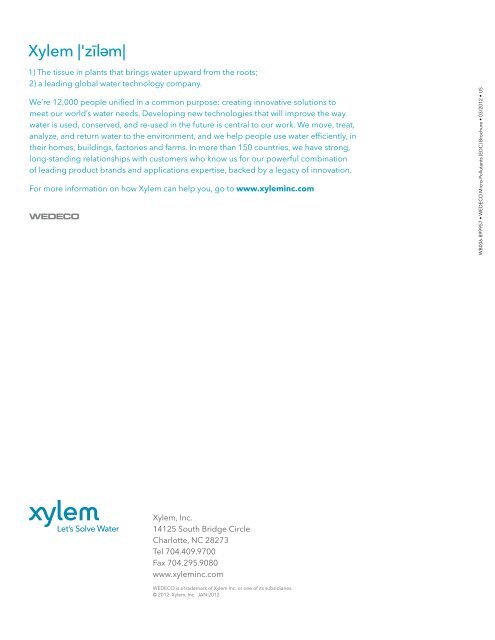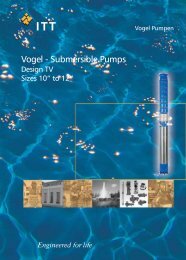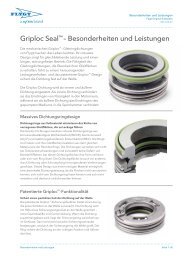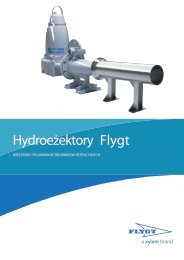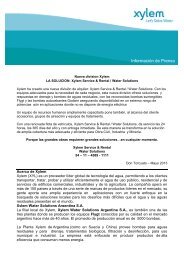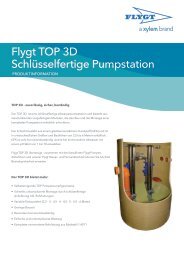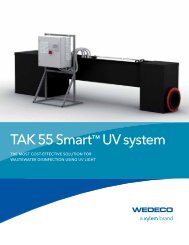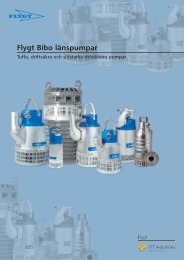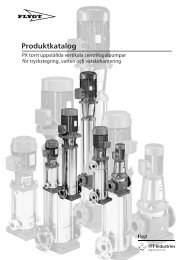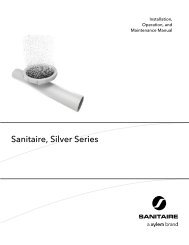WEDECO Micro Pollutants Brochure - Water Solutions
WEDECO Micro Pollutants Brochure - Water Solutions
WEDECO Micro Pollutants Brochure - Water Solutions
You also want an ePaper? Increase the reach of your titles
YUMPU automatically turns print PDFs into web optimized ePapers that Google loves.
Pharmaceutical substances in water circulationThe elimination of micropollutants from our wateris a challenge more facilities are having to address.While conventional treatment processes don’t removethem completely, oxidation with ozone is proving tobe one of the most efficient methods of treatment.Pharmaceuticals help many people and animals whenfighting diseases, staying healthy, or improvingquality of life. Nonetheless, a large proportion ofpharmaceutical agents end up in the environment viawaste from bodily excretion.Although they do not constitute an immediate hazard,it is the long-term dangers that are becoming evenmore significant. The effects of micropollutants andpharmaceutical substances in surface watershave already been proven in numerous large-scalestudies. These effects lead to negative changes withinthe ecosystem.<strong>Micro</strong>pollutants in water circulation• Persistent substances• Only biodegradable to a limited extent• Have a negative effect on organisms• Cause endocrine system disturbances• Can spread rapidly in water suppliesProblem I: PersistenceNot all approved substances in the area of pharmacy,agriculture and industry, as well as those commonlyconsumed are completely biodegradable. Thismeans they cannot be fully removed with conventionaltreatment technologies. As a result, the number ofcontaminants in our water circulation is creeping upward(bioaccumulation). This means a constant rise in waterpollutants and further negative effects on the aquaticenvironment in the future, unless appropriate measuresare taken.Problem II: Endocrine effectSome micropollutants (e.g. ethinylestradiol) have aneffect on the hormonal system of humans and animals.These so-called endocrine disrupting compounds(EDCs) have an impact even at low concentrations andhave been classified as areas of concern. In connectionwith negative environmental influences on livingcreatures, EDCs are currently being considered to belinked to:• Observations of negative effects on thereproduction of certain kinds of fish (including thefeminization of male fish).• The decrease of fertility in humans and animals due toreduced sperm quality.• The increase of certain types of cancer which could berelated to hormonal system disturbance.02
Influx pathsIndustrialWastewaterMunicipalWastewaterHospitalWastewaterSources of drinking water, such asground water or surface water havedifferent micropollutant concentrationsdepending on the degree to which theyintermix with the influx paths.TreatmentSystemWWTPSurface <strong>Water</strong>Ground <strong>Water</strong>TreatmentSystemThe main influx paths or “hot spots” ofpersistent micropollutants in surfacewaters are municipal wastewater treatmentplants, drainage from the pharmaceuticalindustry, animal breeding grounds andmedical centers.Further indirect influx paths resultfrom the improper disposal of unusedpharmaceuticals, agricultural applicationof animal excrements and sewage sludge.Drinking <strong>Water</strong>TreatmentThe main influx paths of endocrine disruptive substances in wastewaters.= possibility of treatment with ozone.High concentrations of endocrine disruptive substances get into our groundwater and surface water via the wastewater treatment process.03
The special agent: ozoneThe effects of endocrine substances and persistentmicropollutants on our ecosystem mean thatmore extensive treatment is necessary. Manywastewater treatment plants are not able tosufficiently eliminate these pollutants with theirexisting technologies.Numerous pilot tests using ozone as an additionaltreatment step indicate ozone is an effectivesolution for eliminating persistent pollutants. Thismeans that micropollutants present in water can besufficiently removed with environmentally friendly andeconomically feasible doses of ozone.How does ozone work?Ozone reacts quickly with micropollutants containingaccessible amino groups, double bonds, or aromaticsystems. Alongside these pollutant-specific attributes,the efficiency of the reactions also depends on thepH value and on dissolved organic carbon (DOC).The extent to which a pollutant can be eliminated canbe estimated by looking at its reaction rate constantswith ozone.<strong>Pollutants</strong> with reaction constants of > 10 5 M-1·s-1 canbe assumed to react very quickly with ozone. Forcomparison: The colorant indigo (which is used forthe quantitative detection of ozone among other things)shows a constant of ~10 7 M-1·s-1 and hydrogen sulfideof ~3x10 4 M-1·s-1 for the reaction with ozone.The varying reaction constants result mainly fromthe different points of action of the ozone on themolecules.• For example, 17α ethinylestradiol is affected at thephenol group.• In the case of carbamazepine, ozone reacts with adouble bond.• Diclofenac and sulfamethoxazole have functionalamino groups which can be oxidized by ozone.Bezafibrate and Ibuprofen have no such functionalgroups and therefore react considerably more slowlywith ozone [Schuhmacher].The table below shows the reaction rate constants ofthe reactions of various pharmaceuticals with ozone.Pharmaceuticalk = [M-1·s-1]EthinylestradiolBezafibrateCarbamazepineDiclofenacIbuprofenSulfamethoxazole~3.0 x 10 6~0.6 x 10 3~0.3 x 10 6~1.0 x 10 6~9.6 x 10 3~2.5 x 10 6Source: Project Poseidon, EAWAG, Huber et al.Ozone dissolution:As soon as ozone is introduced into water, any hazardous pollutantspresent are effectively degraded through oxidation.04
Pharmaceuticals and their effectIn this example, a total of over 2,700 different agents are used in human medicine and over 600 agentsin animal medicine. The table shows the pollutants with the highest concentrations in surface water andtheir effect.Active IngredientsPharmaceuticalDisposal[kg/year]Concentration[µg/L]EffectReactionTotal disposalin 2001Highest concentrationmeasured insurface watersEffects onvarious waterorganismsReaction in theenvironment(poorly degradable)AntibioticsSulfamethoxazoleErythromycinTrimethoprimClarithromycin53,60019,19911,4277,15911.70.20.003XXXXXPain KillersDiclofenacIbuprofenPhenazonePropyphenazone85,801344,88524,84328,14021.50.950.31XXXXXXAntiepilepticsCarbamazepine87,6056.1XXAntilipemicsBezafibrateClofibric acid33,47623.11.1XXBeta-blockersAtenolol13,5940.22XAntirheumaticIndometacin3,7210.7XHormonesEstradiolEthinylestradiol1,098480.00060.002XXX-ray contrast mediaIomeprolIopamidolIopromideDiatrizoate83,37742,99464,05660,6870.892.88.515.8CytostaticsCyclophosphamideIfosfamide3851700.10.18XXSource: MUNLV 2008Terms and definitions<strong>Micro</strong>pollution: Pollution by substances in relatively lowconcentrations, which are persistent against conventionaltreatment.Endocrine Disrupting Compounds (EDC): <strong>Pollutants</strong> withundesired effects on the hormonal system of humans andanimals. These effects can be caused by pharmaceuticals oreven other substances.05
10.00WWTP effluent5 mg/L Ozone10 mg/L Ozone15 mg/L OzoneConcentrationin µ g/L1.000.100.01TrimethoprSulfamethoxErythromyEryth -H2OClarithromyRoxithromyAtenololSotalolMetoprololPropranololCarbamazepClofibric acIbuprofenNaproxenKetoprofenDiclofenacTonalideGalaxolideIopamidolIopromideDiatrizoateAntibioticsBeta-blockersAntiepilepticsAntilipemics MusksX-rayContrast MediaThe graphic shows the results achieved at the wastewater treatment plant in Brunswick with an ozone dosage of 5 to 15 mg/L. They illustrate thehigh degrees of degradation (not shown = under the detection limit) which can be attained with the use of ozone.Successful pilot tests with ozone<strong>WEDECO</strong> ozone systems have already been usedfor several national and international projects formicropollutant reduction:• Project PoseidonBraunschweig Wastewater Treatment PlantJanuary 2001 – June 2004(Project No. EVK1-CT-2000-00047)• National Project of Switzerland Strategy <strong>Micro</strong>PollWueri Wastewater Treatment Plant in RegensdorfJuly 2007 – October 2008• PILOTOX Project at the Technical University of BerlinBerlin Ruhleben Wastewater Treatment PlantDecember 2004 – July 2005• Project PoseidonEAWAG Zurich/Opfikon Wastewater Treatment• Research Project at the University of Stuttgart BusnauWastewater Treatment PlantDecember 2003 – May 2005<strong>WEDECO</strong> ozone plant at the Wueri wastewater treatmentplant in Regensdorf, Switzerland.• KomOzon Project at the Technical University of ViennaVienna Wastewater Treatment Plant2007 – 200906


